|
LIST
OF TABLES AND CHARTS
ECONOMIC
OUTLOOK
The
Alberta economy turned in an impressive performance in 2004, leading
all provinces with real (inflation adjusted) economic growth estimated
at 4.4%. Economic gains were widespread, with the energy, manufacturing
and retail sectors all experiencing strong growth. Alberta also
enjoyed the highest personal income growth and lowest unemployment
rate in Canada, as well as very low inflation.
In
2005, Alberta's economic growth is expected to moderate to a still-robust
3.7%, as energy prices recede from their recent highs. Over the
medium term, growth is expected to average 3.1%, with declining
natural gas production and reduced population growth moderating
the pace of economic expansion to some degree. Alberta will remain
a full-employment economy, with the province's unemployment rate
expected to average 4.3% from 2005 through 2008.
key
energy and economic assumptions


ALBERTA
IN 2004
The
Alberta economy grew by an estimated 4.4% in 2004 – the best
performance of any province. While a thriving energy sector remained
an important engine of growth, Alberta's impressive economic gains
in 2004 came from several sources.
Energy
and Manufacturing Highlight Broad Economic Gains
- Alberta's
energy sector enjoyed another banner year in 2004, supported by
oil prices that reached record highs and averaged US$41.40 per
barrel for the year (up from US$31 in 2003). Following a dramatic
upswing in 2003, conventional energy sector investment strengthened
further last year, with the average number of rigs drilling rising
4.8% to a record high of 329. Oil sands investment increased by
about $1 billion, to an estimated $6.1 billion in 2004.
- The manufacturing
sector showed impressive gains in 2004. Alberta's manufacturing
shipments rose by 14.8% – well above the national growth
rate of 8.4%. Sectors experiencing strong gains included machinery
(+22.7%), chemicals (+16.4%), fabricated metals (+14.5%), and
wood products (+27.8%).

- With manufacturing
leading the way, Alberta's international exports rose sharply
in 2004, despite a strong Canadian dollar. The value of Alberta's
international exports rose by 16.6% in 2004. Manufacturing exports
increased by 21.0%, while energy exports were up by 15.3%. Strong
global demand generated significant increases in both prices and
export volumes, with total real exports rising by an estimated
4.7%.
Highest
Income and Retail Sales Growth and Lowest Unemployment in Canada
-
Albertans enjoyed healthy personal income gains in 2004. Alberta
led all provinces with wage and salary growth of 6.5% in 2004,
well above the national average of 3.9%.
- Rapid
income growth contributed to a remarkable year for Alberta's retail
sector. Alberta led the country in retail sales growth in 2004,
with sales up 11.3%, compared to national growth of 5.0%. On a
per capita basis, Alberta's retail sales remained by far the highest
in Canada, 26% above the national average.
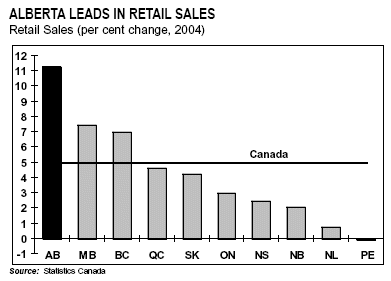
- In 2004,
Alberta's unemployment rate averaged just 4.6%, the lowest in
Canada and down from 5.1% in 2003. The Alberta economy created
40,000 jobs, for employment growth of 2.3%. Sectors experiencing
the largest job gains were construction (+15,700), oil, gas and
mining (+10,300) and retail trade (+10,300).

Other
Developments
- Alberta's
housing sector continued its strong run, with new housing activity
remaining near the 20-year high recorded in 2002. Last year, Alberta's
housing starts were essentially unchanged from 2003 levels, at
36,270 starts. This level was 16% above the most recent 5-year
Alberta average of 31,162 starts.
- The agricultural
sector continued to face significant challenges, with BSE having
substantial economic impacts. Overall growing conditions improved
significantly, although crop quality was reduced in some regions
by an early frost. Farm cash receipts were up 16.0% in 2004, supported
primarily by higher crop receipts. Government program payments
increased by 5.2%, reaching a record high of $1.4 billion.
- Despite rapid
economic growth and very low unemployment, Alberta's CPI inflation
rate fell to only 1.4% in 2004. This was down sharply from a 4.4%
rate in 2003, which was caused mainly by inflation measurement
anomalies associated with natural gas rebates, as well as higher
automobile insurance premiums and tobacco prices.
- For the eighth
consecutive year, Alberta had the highest level of net inter-provincial
migration in Canada, with a net increase of almost 11,000 persons
in 2004. At 1.4%, Alberta once again led all provinces in population
growth.
GLOBAL
ECONOMIC OUTLOOK
The world economy
is coming off its best performance in over two decades. In 2004,
global economic growth was exceptionally strong at an estimated
4.8%, fuelled by strong growth in Asia (China in particular) and
the United States. China's economy expanded by an estimated 9.5%
in 2004, while U.S. economic growth was also robust at 4.4%. Strong
global growth was achieved despite a substantial rise in energy
prices, with the price of oil touching a then-record high of more
than US$55 in 2004, and averaging US$41.40 for the year.
The emergence
of China as a major force in the global economy became increasingly
apparent in 2004. Home to one-fifth of the world's population, China's
economy has expanded by over 25% in real terms over the past three
years alone. The impact of this expansion was felt with particular
force on global commodity markets in 2004. China's oil demand rose
by 18% last year, accounting for almost 40% of the total increase
in global oil demand.
Looking forward,
the global economic outlook remains essentially positive. World
economic growth is expected to remain strong in 2005, at over 4%.
Growth in both China and the United States is expected to moderate
slightly, but remain robust. Economic growth in Japan and the Euro
area is expected to remain relatively sluggish, due, in significant
measure, to the effects of appreciating currencies.
U.S.
Growth Prospects Solid in the Near Term
While U.S. economic
growth is expected to subside somewhat in 2005, most indicators
point to a continuation of solid growth in the near-to-medium term.
U.S. growth is forecast to moderate from 4.4% in 2004 to 3.5% in
2005. The current U.S. expansion should be sustained by a continued
recovery in business investment and rising U.S. exports, the latter
attributable to a continued depreciation of the U.S. dollar. Over
the medium term, U.S. growth is expected to average about 3% annually.
The U.S. Federal
Reserve Board displayed growing confidence in the U.S. economic
recovery in 2004, raising the Federal Funds rate from 1.0% at the
beginning of the year to 2.25% by year's end. In 2005 and beyond,
a continued tightening of U.S. monetary policy is anticipated, with
U.S. short-term interest rates expected to increase at a steady
pace, returning to more normal historical levels in the 4 to 5%
range.
U.S.
Imbalances Remain a Risk
Despite the
global decline in the U.S. dollar in 2004, the U.S. trade and current
account deficits remained unsustainably high, with the current account
deficit reaching a record high of $666 billion (5.7% of GDP) in
2004. Concerns with the U.S. current account are compounded by the
large U.S. budget deficit, which came in at $567 billion1
in 2004 despite very strong U.S. economic growth.
There is some
risk that market concerns with the current account and budget deficits
could lead to greater volatility in currency markets, possibly leading
to a full-scale flight from the U.S. dollar. This, in turn, could
cause a large spike in U.S. interest rates, with significant U.S.
and global economic consequences. Near the end of 2004, currency
markets displayed heightened concerns with the U.S. “twin
deficits,” driving the U.S. dollar to multi-year lows against
several currencies.
The Alberta budget forecast assumes that appropriate U.S. policy
measures will be enacted to address these risks.
1
On-budget deficit (not including transfers from the Social Security
trust fund)
Canadian
Economy Faces Adjustments to a Higher Dollar
Like many other
countries, Canada faces significant economic adjustments as a result
of the dramatic decline in the U.S. dollar. From the start of 2003
to the end of 2004, the Canadian dollar rose from 63.5 cents US
to 83.1 cents US, an increase of 31%.
While the Canadian
economy achieved respectable economic growth estimated at 2.8% in
2004 (up from 2.0% in 2003), there were signs of weakness in the
latter part of the year, especially in exports.
Canada's annual
inflation rate fell to 1.9% in 2004, down from 2.8% in 2003. With
inflation remaining well within the Bank of Canada's target range
of 1 to 3%, and with recent signs of slack in the Canadian economy,
monetary policy remains accommodating. The Bank of Canada's overnight
rate fluctuated somewhat during 2004, ending the year at 2.5% (down
from 2.75% at the beginning of 2004). In view of recent economic
developments, the Bank of Canada is not expected to raise its overnight
rate until the second half of 2005, at the earliest.
With the U.S.
Federal Funds rate rising by an additional 50 basis points in the
first quarter of 2005, U.S. interest rates surpassed Canadian rates
for the first time since 2001. The spread between Canadian and U.S.
short-term interest rates has changed dramatically over the past
15 months, falling from +175 basis points at the beginning of 2004
to -25 basis points in late March of 2005. With further U.S. rate
increases anticipated in the first half of 2005, the negative Canada-U.S.
interest rate spread is expected to widen over the next few months.
Changes in Canada-U.S.
interest rate spreads are expected to stem the rise of the Canadian
dollar, at least in the short term. The Canadian dollar is forecast
to remain near its present level, averaging close to 83 cents US
in 2005. Over the medium term, as Canada's economic growth picks
up and Canadian interest rates rise – and with a continued
global depreciation in the U.S. dollar – the Canadian dollar
is forecast to appreciate further, reaching 85 cents US in 2006.
Canada's real
economic growth is forecast at 2.7% in 2005, essentially unchanged
from 2004. Over the medium term, Canadian growth is expected to
improve to an average of 3.0% annually. With strong economic and
fiscal fundamentals, including the lowest debt-to-GDP ratio among
the G-7 countries and a strong current account balance (+2.6% of
GDP in 2004), Canada is well positioned for a successful adjustment
to developments in the global economy.
Energy
Outlook
Following rapid
increases in 2004, with oil prices averaging a record annual high
of US$45.03 in 2004-05, oil prices are expected to moderate over
the forecast period as global production rises in response to historically
high prices. Prices are forecast to decline to US$42 in 2005-06,
US$32 in 2006-07 and US$31 in 2007-08. The long-term price forecast
of US$30 represents a US$5 per barrel increase over the forecast
price in Budget 2004, reflecting a stronger global oil demand outlook.
With world oil
prices expected to decline over the forecast period, the price of
natural gas is also expected to decline, albeit to a lesser degree.
After averaging an estimated $6.05 per gigajoule (GJ) in 2004-05
(a record annual high), the price of natural gas is forecast to
decline to $5.60 per GJ in 2005-06, moderating further to $5.40
in 2006-07 and $5.20 in 2007-08. These forecast prices remain substantially
above the most recent 5-year average price of $4.44 per GJ.
ALBERTA
ECONOMIC OUTLOOK
Strong
Momentum Carries Over into 2005
The current
momentum of the Alberta economy is expected to carry over into 2005.
Continued strong growth in personal incomes and investment are expected
to sustain above-average economic growth of 3.7% this year.
Solid
Medium Term Growth Prospects
In the medium
term, Alberta is expected to continue to enjoy healthy economic
growth, albeit at a more moderate pace, averaging 3.1% from 2006
through 2008.
Alberta's outstanding
economic and fiscal fundamentals, which include the lowest overall
taxes in Canada and no accumulated provincial debt, provide a strong
foundation for future economic growth. At the same time, there are
some emerging developments in the Alberta economy that are expected
to alter the sources of Alberta's growth over the medium and longer
term. These developments include declining natural gas production
and slower population growth.

Sources
of Alberta's Economic Growth Are Changing
With
Alberta's natural gas production presently in decline due to diminishing
reserves, natural gas is not expected to be a future source of growth
for the Alberta economy, as it has been over much of the past two
decades. While Alberta's natural gas production rose by an average
of 5.2% annually between 1990 and 2000 (for a total production increase
of 66%), production has declined by an estimated 3.5% since 2001.
Although non-conventional natural gas (e.g. natural gas in coal)
offers significant potential for the future, there remains a high
degree of uncertainty regarding the feasibility of large-scale production
from these alternative sources.
The
contribution of non-energy exports to Alberta's economic growth
has become increasingly evident over the past decade. Manufacturing
and services exports accounted for 68% of Alberta's total real exports
in 2003 (up from 57% in 1993), reflecting the growing diversification
of the Alberta economy.
In
recent years, improved economic conditions in other regions of Canada
have led to a moderation in the pace of migration to Alberta. In
2003 and 2004, net inter-provincial migration to Alberta averaged
about 11,400 per year – still the highest of any province,
but down considerably from recent historical levels (net migration
averaged over 27,000 persons annually from 1997 through 2002). This
development slowed Alberta's population growth, which at 1.4% in
2004 was still the highest in Canada, but down from an average of
2.0% during the 1997-2002 period. These changing migration and population
patterns are expected to change the nature of Alberta's economic
growth over the forecast period.
With
these emerging trends, Alberta will rely increasingly on business
investment, consumer spending, and non-energy exports as the key
sources of future economic growth.
Sector
Highlights
Robust
growth should continue in Alberta's consumer/household sector, supported
by strong economic conditions, including low unemployment and healthy
income gains. Consumer spending is expected to increase by 3.7%
annually in real terms through 2008. One moderating influence on
growth during the forecast period will be new housing activity,
which is expected to recede gradually from its current high pace,
with housing starts declining from 36,270 in 2004 to a projected
30,500 in 2008.
With
an anticipated moderation in U.S. import demand over the forecast
period due to both slightly lower U.S. economic growth and the impact
of a depreciating U.S. dollar, Alberta exports are forecast to grow
at an average rate of 2.7% annually (in real terms) through 2008.
While solid, this is below the estimated 4.7% real growth rate achieved
in 2004.
Alberta's employment market will remain strong, with the unemployment
rate expected to average just 4.3% over the forecast period. Employment
growth is forecast to remain healthy, averaging 1.9% annually through
2008, constrained primarily by the growth rate of Alberta's population
and labour force.
The
growth outlook for Alberta's agricultural sector remains highly
uncertain. In view of the significant uncertainties associated with
Canadian live cattle trade, as well as post-BSE infrastructure constraints
(for example, reduced trucking capacity), only modest increases
in livestock receipts are incorporated into the forecast in 2005,
with further gradual improvements in future years. If, however,
live cattle exports return to pre-BSE levels more rapidly than anticipated,
near-term growth prospects for Alberta's agricultural sector could
improve substantially.
Inflation
is expected to remain low. While some additional wage pressures
are anticipated as Alberta's already-low unemployment rate declines
even further over the forecast period, these pressures should be
offset to some degree by lower costs for imported goods, due to
a higher Canadian dollar. Alberta's inflation rate is expected to
average just 1.9% annually through 2008.
Alberta's
Investment Strength Points to a Healthy Economic Future
Alberta
has historically enjoyed a strong advantage within Canada in terms
of investment, with real business investment averaging about 20%
of the province's economic output. The comparable national average
has generally been in the range of 10 to 12% of GDP. Investment
is an important contributor to growth, increasing current economic
output and employment, and raising productivity on an ongoing basis.
In recent years,
Alberta's investment advantage has strengthened even further. For
the most recent 5-year period, Alberta's real business investment
has averaged a remarkable 24% of GDP.

Alberta
business investment is expected to show continued strong growth
over the forecast period, sustained by an unmatched investment climate
with low tax rates and sensible regulation. Investment will be further
supported by lower costs for imported machinery and equipment, due
to the higher Canadian dollar. Through 2008, Alberta's business
investment is projected to grow by an average of 5.5% annually in
real terms.
These
developments suggest that Alberta will retain its position as Canada's
most dynamic and prosperous economy. The Alberta economy is exceptionally
well positioned to continue its evolution into a mature and increasingly
diversified economy, with investment, innovation and productivity
gains providing the foundation for sustained healthy economic growth.
RISKS
- A greater
than expected decline in world energy prices could have a negative
impact on Alberta's energy sector. On the other hand, if energy
prices remain at historically high levels, prospects for global
economic growth could be negatively affected.
- A further
substantial appreciation of the Canadian dollar would have a negative
effect on export volumes, and thus economic growth. In addition,
provincial oil and gas revenues would decline, due to lower returns
for energy exporters.
- Since energy
exports are transacted in U.S. dollars, higher energy prices are
required to achieve a given financial return for Alberta producers.
With the U.S. dollar depreciating by more than 20% against the
Canadian dollar over the past two years, a US$30 price for a barrel
of oil today is roughly equivalent to a price of US$25 two years
ago.
- Developments
regarding BSE remain a risk factor for the agricultural outlook.
Since the forecast assumes only a very gradual increase in live
cattle exports, an accelerated recovery in this sector would improve
the outlook for the agricultural sector and economic growth.
- The U.S.
budget and current account imbalances represent a continuing risk
to the forecast, with the potential to significantly reduce U.S.
and global economic growth in the medium term.

SENSITIVITIES
TO FISCAL YEAR ASSUMPTIONs, 2005-06a


Strongest
global growth in decades
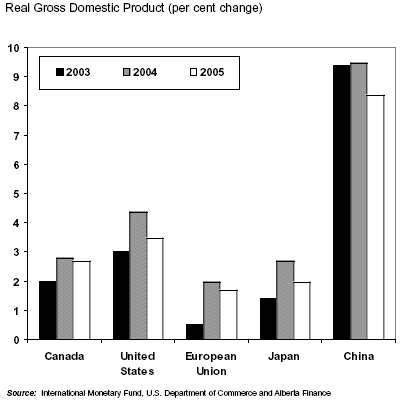
- In 2004,
the global economy had its strongest performance in over two decades,
expanding by an estimated 4.8% in real terms.
- China continued
its emergence as a major economic power, playing a key role in
global economic developments in 2004. China's real economic growth
was an estimated 9.5%.
- The United
States also enjoyed robust growth of 4.4%, its strongest performance
in 5 years. U.S. growth was supported by a continued recovery
in business investment and strong consumer spending.

rising
dollar affects Canadian economic Growth
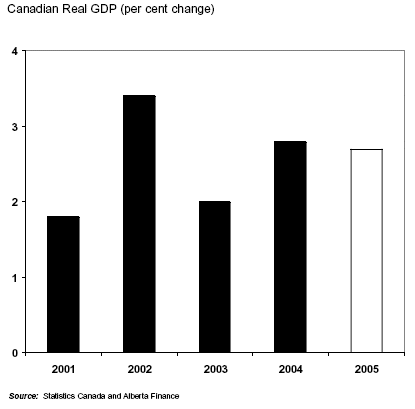
- In 2004,
the continued rise of the Canadian dollar had a discernible impact
on Canada's economic growth.
- Canada's
real economic growth was a respectable 2.8% in 2004. Growth was
constrained by a decline in exports in the latter half of the
year, attributable largely to the higher Canadian dollar.
- While the
Canadian economy remains fundamentally sound, adjustments to the
high dollar are expected to constrain Canada's growth in the near
term. Economic growth is forecast at 2.7% in 2005, rising to an
average of 3.0% over the medium term.

CANADIAN
JOB GROWTH remains steady

- Despite losses
in export-sensitive industries such as manufacturing, the Canadian
employment market remained solid in 2004, creating 284,600 jobs,
for employment growth of 1.8%.
- With continued
steady job gains, Canada's unemployment rate fell from 7.3% in
January 2004 to 7.0% in December. The annual unemployment rate
of 7.2% was the lowest in 3 years.

INFLATION
remains low

- Despite a
large jump in energy prices, Canada's inflation rate remained
low in 2004. The annual CPI inflation rate fell from 2.8% in 2003
to 1.9% in 2004, remaining well within the Bank of Canada's target
band of 1 to 3 per cent.
- Alberta enjoyed
very low CPI inflation in 2004, at just 1.4% (down from 4.4% in
2003).
- The Bank
of Canada expects core inflation to remain below 2% into late
2005, due to modest underlying price pressures and spare capacity
in the Canadian economy.

Canada-U.S.
interest rate spread eliminated

- The U.S.
Federal Reserve raised the Federal Funds rate from 1.0% at the
beginning of 2004 to 2.75% in early 2005.
- With the
Bank of Canada lowering its overnight rate from 2.75% to 2.5%,
the spread between Canadian and U.S. interest rates fell from
+175 basis points at the beginning of 2004 to -25 basis points
by late March of 2005.
- The Federal
Reserve is expected to continue to raise interest rates throughout
2005, while the Bank of Canada is expected to remain cautious
through the first half of the year, due to recent signs of slack
in the Canadian economy.

Canadian
Dollar reaches a 12-year high

- Despite narrowing
Canada-US interest rate spreads, the Canadian dollar continued
to appreciate in 2004, touching a 12-year high of 85 cents US
in November. The Canadian dollar has risen from a low of 63.5
cents at the start of 2003.
- The rapid
increase in the Canadian dollar was part of a global phenomenon,
which saw the U.S. dollar decline against most major world currencies.
- With the
U.S. dollar expected to decline further on global currency markets
in the medium term, the Canadian dollar is expected to remain
strong over the forecast period, rising to 85 cents US in 2006
as Canada’s economic growth strengthens.

Oil
Prices reach record highs

- As a result
of robust global economic growth, particularly in China, world
oil prices rose sharply in 2004, touching a then-record high of
US$55, and averaging US$45.03 in 2004-05.
- Concerns
regarding supply disruptions in Iraq, Nigeria and Russia also
played a role in raising oil prices.
- With anticipated
increases in global oil production in response to current high
prices, supply constraints are expected to ease over the forecast
period. Prices are expected to return to a long-run level of around
US$30 by 2008.

NATURAL
GAS PRICES remain high
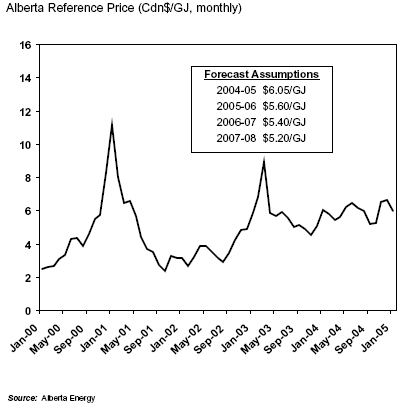
- In 2004,
natural gas prices were supported at above-average levels by record
high prices for oil (a substitute for natural gas) even though
natural gas storage levels were healthy for most of the year.
Natural gas prices averaged an estimated $6.05 per gigajoule (GJ)
in 2004-05, a record annual high.
- Prices are
expected to decline to an average of $5.60/GJ in 2005-06, moderating
further to $5.40/GJ in 2006-07 and $5.20/GJ in 2007-08, due largely
to declining oil prices.

CONVENTIONAL
energy sector sees record activity
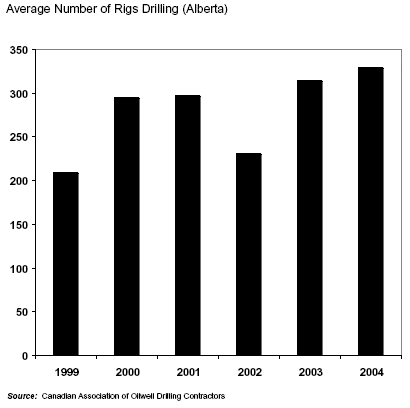
- Alberta's
conventional oil and gas sector enjoyed another record year of
activity. The average number of rigs drilling in Alberta increased
by 4.8% in 2004, following a 36% increase in 2003.
- While energy
prices are forecast to moderate, they are expected to remain relatively
high by historical standards, sustaining drilling activity at
healthy levels throughout the forecast period.

NON-CONVENTIonAL
OIL STILL GROWING

- In 2002,
non-conventional oil overtook conventional oil as Alberta's largest
source of production.
- By 2008,
it is expected that non-conventional oil will make up approximately
74% of Alberta's total oil production.

OIL
SANDS INVESTMENT REMAINs HIGH

- Oil sands
investment increased dramatically between 1995 and 2002, rising
from under $1 billion to over $6 billion.
- Following
a moderate decline in 2003 to about $5.2 billion, oil sands investment
rose again in 2004 to an estimated $6.1 billion.
- Ongoing projects
are expected to keep investment levels high, limited primarily
by construction industry capacity constraints.

BUSINESS
INVESTMENT sustains healthy economic GROwth

- Over the
past 5 years, Alberta's real business investment has grown at
an estimated rate of 6.7% annually, becoming a key engine of economic
growth.
- Alberta's
total real business investment is expected to increase at an average
rate of 5.5% over the forecast period, supporting productivity
gains and sustaining healthy economic growth.

ALBERTA'S
EXPORTS REMAIN STRONG

- Despite the
rising Canadian dollar, Alberta's exports had a very strong year
in 2004, rising by an estimated 4.7% in real terms. Manufacturing
exports led the way, with volumes rising by an estimated 8.0%.
- Overall,
Alberta's exports are expected to rise by 2.7% per year in real
terms through 2008.
- Future growth
will be driven increasingly by non-energy exports, as Alberta’s
natural gas exports decline.

manufacturing
and services exports growing

- Alberta's
export profile has become increasingly diverse over the past decade,
with real manufacturing and services exports rising from 57% of
total exports in 1993 to 68% in 2003.
- The diversification
of Alberta's export sector provides a strong foundation for broadly-based
future export growth.

WAGE
LEVELS AMONG HIGHEST IN CANADA

- For 2004
as a whole, Alberta's average weekly earnings were second only
to Ontario's.
- In 2004,
Alberta's wages and salaries grew by 6.5%, the highest rate of
growth in Canada.
- Over the
medium term, wages are expected to increase at a rate slightly
above inflation, sustained by productivity gains in the Alberta
economy.

HIGHEST
DISPOSABLE INCOME IN CANADA

- At $25,654,
Alberta had the highest average personal disposable income of
any province in 2003, the latest year for which data is available.
- In 2003,
Alberta's disposable income per capita was more than $3,100 (13.8%)
above the Canadian average of $22,538.

housing
starts remain strong

- Alberta's
housing starts remained at high levels in 2004. Strength in the
housing sector was supported by Alberta's robust economy and labour
market, along with low interest rates.
- Although
down slightly from the 20-year high recorded in 2002, Alberta's
36,270 housing starts in 2004 were 16% above the average number
of starts over the preceding five years.
- Over the
medium term, housing starts in Alberta are expected to moderate
from recent highs, receding gradually to a still-healthy level
of just over 30,000 starts by 2008.

alberta
job growth to remain strong
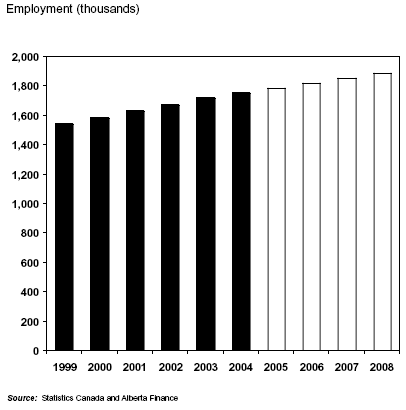
- In 2004,
the Alberta economy created 40,000 jobs, for solid employment
growth of 2.3%.
- Over the
forecast period, employment growth is expected to average around
1.9% per year, supported by continued healthy Alberta economic
growth. Lower population growth is expected to be a key constraint.
- The Alberta
economy is expected to generate almost 134,000 new jobs from 2004
to 2008, an average of about 33,400 per year.

interprovincial
migration levels moderating

- In 2004,
for the eighth consecutive year, Alberta had the highest level
of net interprovincial migration of any province. From July 1,
2003 to June 30, 2004, 10,902 Canadians moved to Alberta.
- While Alberta
remains the destination of choice for Canadians moving from other
provinces, migration levels have been moderating in recent years,
due to improving economic conditions in other regions of Canada.
Net interprovincial migration to Alberta peaked at over 43,000
in 1998.
- Over the
forecast period, Alberta's continuing strong economy is expected
to attract an average of 14,100 net interprovincial migrants per
year.

lowest
unemployment rate in canada

- Healthy employment
growth led to a further decline in Alberta's unemployment rate,
which fell from 5.1% in 2003 to 4.6% in 2004.
- Alberta's
2004 unemployment rate was the lowest of any province, and more
than one third below the national unemployment rate of 7.2%.
- With continued
healthy economic growth forecast for Alberta, unemployment is
expected to decline further over the forecast period, averaging
only 4.3% through 2008.

OIL PRICE
FORECAST BENCHMARK


tracking
the forecasts of oil prices


natural
gas Price forecast benchmark


TRACKING
THE FORECASTS OF natural gas PRICES


canadian
short-term interest rate forecast benchmark
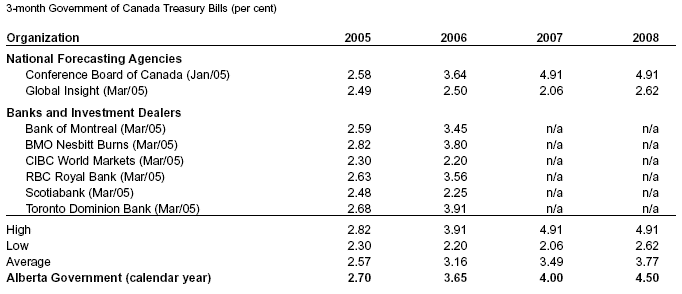

canadian
long-term interest rate forecast benchmark


canada/united
states exchange rate forecast benchmark
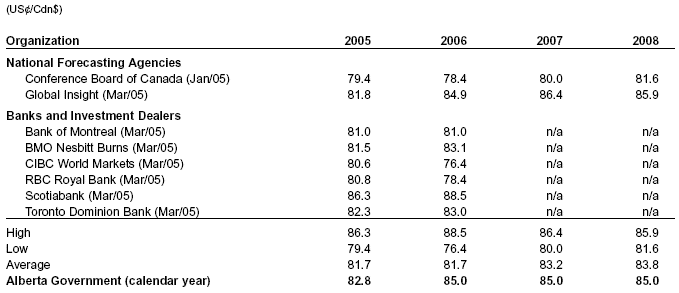

alberta
real gross domestic product forecast benchmark


announced
major projects over $100 million
Proposed
or Under Construction
| Company
Name |
Location |
Type
of Project |
Cost
($millions) |
Timing |
| OIL
AND GAS |
|
|
|
|
| Air
Products Canada Ltd. |
Strathcona
County |
Hydrogen
Plant for Petro-Canada Edmonton Refinery Feed Conversion
Project |
160 |
2006 |
| Imperial
Oil Limited |
Strathcona County |
Strathcona
Sulphur Reduction Plant for Diesel |
250 |
2004-2006 |
| Petro-Canada
Oil and Gas |
Strathcona
County |
Sulphur
Reduction Plants at
Strathcona Refinery |
250 |
2004-2006 |
| TransCanada
Pipelines |
Yellowhead
City
(NW of Edson) |
Natural
Gas Storage Facility |
200 |
2004-2005 |
| OILSANDS |
|
|
|
|
Canadian
Natural Resources
Ltd. |
Lakeland
County (Primrose/Wolf Lake) |
‘Primrose
North’ Cyclic Steam Stimulation (CSS) Project |
250 |
2004-2007 |
| |
RM
of Wood Buffalo |
‘Project
Horizon’ Mining and Drilling Project Phase 1 |
6,800 |
2005-2008 |
| Conoco
Philips Canada/TotalFinaElf/Devon Energy |
RM
of Wood Buffalo (near Anzac) |
‘Surmont’
SAGD* Bitumen Commercial Project |
1,100 |
2004-2013 |
| Deer
Creek Energy Ltd. |
RM
of Wood Buffalo |
‘Joslyn
Creek’ SAGD Project Phase 2 |
270 |
2004-2006 |
| Devon
Canada Corporation |
RM
of Wood Buffalo
(SE of Conklin) |
‘Jackfish’
SAGD Project |
450 |
2005-2007 |
| EnCana
Corporation |
RM
of Wood Buffalo (Christina Lake) |
SAGD
Bitumen Production |
400 |
2000-2009 |
| ExxonMobil
Canada Ltd. |
MD
of Bonnyville
(near Cold Lake)
|
In
situ Bitumen Plant |
100 |
1997-2005 |
| Husky
Energy Inc. |
MD
of Bonnyville
(NW of Cold Lake) |
‘Tucker
Lake’ SAGD Project |
500 |
2005-2006 |
| Imperial
Oil Limited |
MD
of Bonnyville |
Extension
of Phases 9 & 10
‘Mahihkan North’ |
350 |
2005-2006 |
| OPTI
Canada Inc./Nexen Inc. |
RM
of Wood Buffalo
(near Anzac) |
‘Long
Lake’ SAGD Heavy Oil Project’ |
3,500 |
2004-2007 |
| Petro-Canada
Oil and Gas |
Strathcona
County |
Strathcona
Refinery Conversion to Upgrade Bitumen |
1,200 |
2006-2008 |
| Petrovera
Resources Ltd. |
Lindbergh/Elk
Point/
Frog Lake/Marwayne |
Bitumen
Recovery |
1,200 |
2000-2010 |
| Suncor |
RM
of Wood Buffalo
(Fort McMurray) |
‘Firebag’
In situ Bitumen Recovery Project |
1,000 |
2003-2012 |
| Syncrude
Canada |
RM
of Wood Buffalo
(Fort McMurray)
|
Phase
3: Upgrader Expansion Phase 1/Aurora Mine Train 2 |
7,800 |
2001-2006 |
| |
RM
of Wood Buffalo
(Fort McMurray) |
Continuous
Improvement |
1,500 |
1997-2007 |
| POWER
|
|
|
|
|
| Hunt
Power Company Ltd. |
MD
of Rocky View (south of Crossfield) |
Gas-Fired
Power Plant (345MW) |
300 |
2005-2007 |
| COMMERCIAL,
RETAIL and RESIDENTIAL CONSTRUCTION |
|
|
|
|
| Bentall
Real Estate Services |
Calgary |
‘Livingston
Place’ Office Towers
Phase 1 |
130 |
2005-2007 |
| Cameron
Corporation/ Grosvenor International Canada
Ltd. |
Edmonton |
'South
Edmonton Common' Retail Complex |
250 |
1997-2005 |
| Christenson
Developments/Western Asset Management Group (WAM) |
Strathcona
County (Sherwood Park) |
‘Centre
in the Park’ Housing/Retail/Commercial Development |
135 |
2004-2011 |
| Heritage
Partners |
Calgary |
'Deerfoot
Commons' Retail Complex |
500 |
2003-2006 |
| ProCura
Real Estate Services/Westbank Projects Corp. |
Edmonton |
Heritage
Mall Re-development to ‘Century Park’ Mixed-Use
Development |
600 |
2005-2010 |
| WAM
Development/Opus Building Corp. |
Calgary |
‘Stampede
Station’ Retail/Office Space, Hotel and Residential
Buildings |
400 |
2004-2007 |
| INFRASTRUCTURE |
|
|
|
|
| Alberta
Infrastructure and Transportation |
Across
Alberta
|
Highway
Twinning Project |
1,400 |
1998-2011 |
| |
Bow
River Irrigation District |
Carseland
- Bow River Headworks Rehabilitation |
125 |
2003-2009 |
| |
Calgary |
Extension
of Stoney Trail to Deerfoot Trail |
250 |
2005-2007 |
| |
Edmonton |
SH216
(Anthony Henday Dr) SE Section (Hwy 2 to Hwy 14/SH216) |
493 |
2005-2007 |
| |
Near
Carseland to near Vauxhall |
Carseland
- Bow River Headworks System Rehabilitation |
100 |
1998-2012 |
| Calgary
Airport Authority |
Calgary
|
Airport
Improvements |
800 |
1998-2007 |
| City
of Calgary |
Calgary |
Bearspaw
Water Treatment Plant Upgrades |
102 |
2004-2008 |
| |
MD
of Foothills |
Pine
Creek Wastewater Treatment Plant |
320 |
2005-2007 |
| Various
Irrigation Districts |
Across
Southern Alberta |
Irrigation
Systems/Rehabilitation |
600 |
1997-2006 |
| INSTITUTIONAL |
|
|
|
|
Alberta
Children’s Hospital
Foundation/Calgary Health
Region |
Calgary
|
Alberta
Children's Hospital |
220 |
2003-2006 |
| Bow
Valley College |
Calgary |
Campus
Re-Development and Expansion |
100 |
2005-2010 |
| Calgary
Health Region |
Calgary |
Hospital
for South Calgary (South Health Campus Phase 1) |
500 |
2006-2009 |
| Capital
Health |
Edmonton |
Alberta
Heart Institute |
142 |
2004-2006 |
| Capital
Health/Royal Alexandra Hospital Foundation |
Edmonton |
Royal
Alexandra Hospital North Treatment Centre (NTC) |
110 |
2005-2008 |
GWL
Realty Advisors Inc. (formerly listed under Alberta
Infrastructure/Alberta Justice) |
Calgary |
Courts
Centre Courthouse Complex |
300 |
2004-2007 |
| University
of Alberta |
Edmonton |
Health
Research Innovation Facility (HRIF) |
165 |
2003-2006 |
| University
of Calgary |
Calgary |
Health
Research Innovation Centre (HRIC) |
220 |
2003-2005 |
| OTHER |
|
|
|
|
| Ainsworth
Lumber Co. |
Grande
Prairie and Valleyview
|
OSB
Plant Expansion plus Hardwood Sawmill Expansion |
220 |
2005-2006 |
| Bell
Intrigna/Bell Nexxia/Axia NetMedia and Partners |
Across
Alberta
|
Alberta
SuperNet Fibre-Optic Communications Grid |
300 |
2001-2005 |
| Destination
Resorts Inc. |
Canmore |
Three
Sisters Resort |
150 |
2002-2010 |
| Enoch
Paragon Limited Partnership (EPLP) |
Parkland
County (Enoch Cree Nation) |
‘River
Cree Resort and Casino’ Complex |
140 |
2004-2006 |
| Tolko
Industries Inc. |
Slave
Lake
|
Facility
Expansion and
Improvements to OSB Plant |
202 |
2005-2006 |
| Tsuu
T’ina Nation |
MD
of Rocky View
|
Casino/Business
Centre |
300 |
2001-2005 |
| Weyerhauser |
Grande
Prairie |
Pulp
Mill Upgrade (Boiler Re-Build) |
700 |
2005 |
| Enoch
Paragon Limited Partnership (EPLP) |
Parkland
County (Enoch Cree Nation) |
‘River
Cree Resort and Casino’ Complex |
160 |
2005-2007 |
| TOTAL |
|
|
37,414 |
|
Source:
Alberta Economic Development

Go
to: The
Alberta Advantage
|










